 When is the best time to open one for your child?
When is the best time to open one for your child?
How financially savvy are your kids?
Depending on your answer, our friends at Balance Financial Fitness offer some great advice.
According to a recent survey, only 5% of adults received any kind of financial education in school. It is a scary statistic, and may partially explain consumers’ record-high credit card and student loan debt.
If you want to equip your kids with the tools to be financially secure adults, a good place to start is with a savings and/or checking account. Once they see money going in and coming out, it can drive home a lesson about money management.
Wondering if they can handle the responsibility?
Savings Accounts
Most kids can typically grasp the concept of a savings account early in their development. Here’s how to know if your children are ready to use one:
-
They’re curious about money - If your child expresses a genuine interest in coins, shopping, or anything related to money, this can be a good segue into a savings lesson: financial institutions allow you to put money aside until you really need it.
-
Their piggy bank is overflowing - If your kids have a lot of change in their piggy bank, watch out. It may disappear before your eyes. Take this opportunity to teach them that if they save some of their money in an account, it can earn interest or dividends over time.
-
They have a savings goal - If your children are saving up for something big, this is the perfect time to introduce a savings account. They can make a deposit into the account so they will not be tempted to spend all of their cash.
Checking Accounts
Checking accounts tend to be better suited to older kids who have had more exposure to money. Here are some signs that your kids could benefit from a checking account:
-
They’re responsible - No matter how responsible you are, it can be tempting to withdraw more cash than you should. You might wait to open an account with your children until they demonstrate responsibility in other areas, such as getting a driver’s license or maintaining a part-time job.
-
All their cash is stuffed into their wallet - The wallet-as-checking-account is dangerous for several reasons. Not only can cash easily get lost, it’s hard to track your purchases. By contrast, an account statement lets you view all of your spending and withdrawal activity, which can be handy for budgeting and a great teaching tool.
If you’re eager to introduce your children to the world of personal finance, checking and savings accounts are a good place to start. Just watch for the signs, and start when they’re ready.
Save Smarter
Learn about the different types of Youth Accounts, and their benefits, on our Youth Accounts page. Call 315-735-8571 to discuss any questions you may have or make an appointment with one of our friendly and knowledgeable representatives today. Simply click on the button below, select the “New Accounts” service from the menu and choose “Youth Account”.
Source: Balance Financial Fitness March 2019